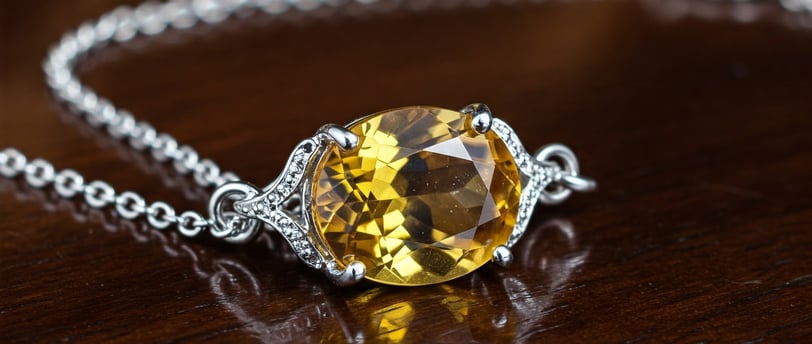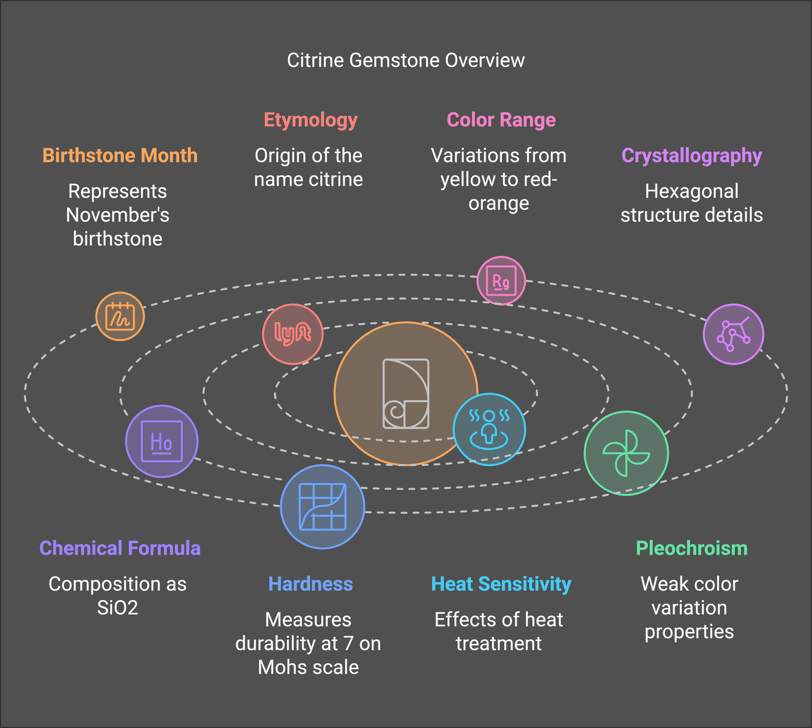Citrine
Citrine: A Gemstone Guide exploring the history, quality factors, and care of this beautiful yellow to reddish-orange variety of quartz, often used as a modern alternative birthstone for November.
1/30/20253 min read


History
Citrine, a variety of transparent quartz, has been admired for its warm, golden hues, often likened to a gift from the sun. The name "citrine" originates from the French word "citron," meaning lemon. In ancient times, citrine was believed to offer protection against snake venom and negative thoughts. The gemstone saw a surge in popularity during the 1940s, when its sunny colour and bold proportions complemented the era’s streamlined designs and use of gold. It was often combined with rubies, peridot, and aquamarine in brooches, necklaces, and bracelets. Citrine is now a modern alternative birthstone for November. It is also recognised as the gem that commemorates the thirteenth anniversary.
Mineral Origins
Citrine is a yellow to reddish-orange variety of crystalline quartz. Its colour comes from trace amounts of iron in its crystal structure. While natural citrine is relatively rare, it is available in large sizes and is a durable choice for jewellery. Most citrine on the market is produced by heat-treating other quartz varieties such as amethyst and smoky quartz. The majority of natural citrine comes from Brazil. Other notable sources include Zambia.
The 4 C’s
Colour
The most desirable citrine colours are bright and bold, ranging from saturated yellow to reddish orange, without any brownish tints. These colours reach peak saturation at relatively light tones, around 20-30%. However, with the rise in popularity of earth tones, brownish orange hues are also in demand. Madeira citrines, which are orange-red and darker in tone, are also highly valued, often the result of heat treatment. Citrines with less intense colours are of lower value, with pale or smoky stones at the bottom of the range. Colour zoning should be avoided in citrines, as uniform colour is preferred.
Clarity
Citrine is abundant and often free of inclusions. Inclusions are particularly undesirable in pale gems, where they are more visible. When purchasing citrine, aim for high transparency and avoid gems with low clarity grades. Most faceted citrine on the market is "eye-clean," meaning it lacks eye-visible inclusions. Material with minor inclusions is often used for cabochons or carvings.
Carat
Large sizes of citrine are not uncommon, therefore, the price per carat does not increase dramatically for larger stones. Citrines of up to 20 carats are readily available in jewellery. Smaller citrines can have strong colour, making them easier to match in sets of different sizes.
Cut
Citrine is available in virtually any cut due to its abundance and availability. Poorly cut citrines do not hold much value. It is important to ensure that the citrine is cut symmetrically with the correct proportions and that there is no window in the gem. Custom cuts and intricate carvings are common, and citrine geodes can be used in jewellery.
Be Aware Of
Enhancements
Few citrines are naturally found with bright and bold colours. Heat treatment is a stable process commonly used to produce the prized citrine colours. This process is fully accepted within the gem trade and requires no further care. Smoky quartz can be heat treated to create yellow citrine, and amethyst is heat treated to produce stronger yellows and orange-red to orangey brown shades. Additionally, colourless quartz can be irradiated and heat-treated to create a greenish "lemon" colour. Any heat treatment should be disclosed on the stone's bill of sale.
Simulants
Due to its colour, citrine has historically been confused with topaz. Citrine has been misleadingly referred to as “Brazilian topaz,” “Madeira topaz,” and “topaz quartz”. However, citrine and topaz are distinct gem species. It is also important to differentiate citrine from scapolite, which can be misidentified as citrine.
Synthetics
Despite the low cost of natural quartz, synthetic citrines are readily available. Synthetic quartz can be manufactured at low cost, making it economically viable. Quartz is grown in laboratories for industrial purposes and to make laboratory-grown amethyst, with some of this material becoming laboratory-grown citrine quartz.
Final Thoughts
Buying Tips
When buying citrine, look for eye-clean gems with lively, pleasing colour and attractive cutting styles. The finest citrines are saturated in colour, without brownish tints. Look for gems that are cut symmetrically with the correct proportions. Be aware that most citrine on the market is the result of heat treatment. Custom cutting can increase value, as can fancy cut or carved specimens.
Jewellery Care
Citrine is a durable gemstone that can be used for any jewellery application. Citrine is fairly durable, but abrupt temperature changes can fracture it. Heat-treated stones may fade when exposed to heat. Avoid steam cleaning or boiling your citrine jewellery. Warm, soapy water is always safe for cleaning citrine. Ultrasonic cleaning is also suitable for most heat-treated citrines. Stones with low clarity grades should be cleaned by hand only. Like all fine jewellery, citrine should be removed before sleeping.


Gemius Stones
Expertise
© 2025. All rights reserved.
